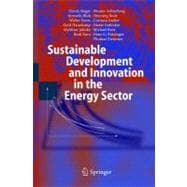
What is included with this book?
| Summary | 1 | (22) | |||
|
17 | (6) | |||
|
17 | (1) | |||
|
17 | (2) | |||
|
19 | (1) | |||
|
20 | (3) | |||
| 2 Terminological and Conceptional Foundations | 23 | (28) | |||
|
23 | (7) | |||
|
23 | (1) | |||
|
24 | (3) | |||
|
27 | (3) | |||
|
30 | (4) | |||
|
31 | (1) | |||
|
32 | (2) | |||
|
34 | (17) | |||
|
34 | (1) | |||
|
35 | (2) | |||
|
37 | (6) | |||
|
43 | (2) | |||
|
45 | (6) | |||
| 3 Normative Criteria for Evaluation and Decision-Making | 51 | (14) | |||
|
51 | (4) | |||
|
51 | (1) | |||
|
52 | (3) | |||
|
55 | (6) | |||
|
55 | (1) | |||
|
56 | (1) | |||
|
57 | (3) | |||
|
60 | (1) | |||
|
61 | (1) | |||
|
62 | (3) | |||
| 4 Towards a Sustainable Energy System - Legal Basis, Deficits and Points of Reference | 65 | (40) | |||
|
65 | (16) | |||
|
65 | (6) | |||
|
71 | (4) | |||
|
75 | (1) | |||
|
75 | (1) | |||
|
76 | (1) | |||
|
77 | (2) | |||
|
79 | (2) | |||
|
81 | (18) | |||
|
81 | (1) | |||
|
82 | (3) | |||
|
85 | (4) | |||
|
89 | (7) | |||
|
96 | (3) | |||
|
99 | (6) | |||
|
99 | (2) | |||
|
101 | (4) | |||
| 5 Potentials for the Sustainable Development of Energy Systems | 105 | (24) | |||
|
105 | (1) | |||
|
106 | (6) | |||
|
112 | (5) | |||
|
117 | (7) | |||
|
124 | (5) | |||
|
124 | (2) | |||
|
126 | (1) | |||
|
127 | (2) | |||
| 6 The Reality of Sustainability: Conflicts of Aims in the Choice of Instruments | 129 | (26) | |||
|
129 | (2) | |||
|
131 | (10) | |||
|
131 | (4) | |||
|
135 | (1) | |||
|
136 | (1) | |||
|
137 | (2) | |||
|
139 | (1) | |||
|
140 | (1) | |||
|
141 | (8) | |||
|
142 | (1) | |||
|
143 | (1) | |||
|
143 | (3) | |||
|
146 | (1) | |||
|
146 | (2) | |||
|
148 | (1) | |||
|
149 | (6) | |||
| 7 Strategies for Accelerating Sustainable Energy Innovations | 155 | (38) | |||
|
155 | (3) | |||
|
158 | (3) | |||
|
158 | (1) | |||
|
159 | (1) | |||
|
160 | (1) | |||
|
161 | (12) | |||
|
163 | (4) | |||
|
167 | (4) | |||
|
171 | (2) | |||
|
173 | (3) | |||
|
173 | (2) | |||
|
175 | (1) | |||
|
176 | (2) | |||
|
178 | (7) | |||
|
178 | (1) | |||
|
179 | (1) | |||
|
180 | (3) | |||
|
183 | (2) | |||
|
185 | (2) | |||
|
187 | (6) | |||
|
187 | (1) | |||
|
188 | (2) | |||
|
190 | (3) | |||
| 8 On the Political Enforceability of a Sustainable Innovation Strategy | 193 | (18) | |||
|
193 | (1) | |||
|
193 | (7) | |||
|
200 | (3) | |||
|
203 | (3) | |||
|
206 | (5) | |||
| 9 Responsibility for the "Energy Hunger" of the Developing Countries - How Sustainable Energy Innovations Can Help | 211 | (12) | |||
|
211 | (1) | |||
|
212 | (2) | |||
|
214 | (3) | |||
|
217 | (1) | |||
|
218 | (3) | |||
|
221 | (2) | |||
| Appendix | 223 | (28) | |||
|
223 | (10) | |||
|
223 | (1) | |||
|
224 | (1) | |||
|
225 | (8) | |||
|
233 | (8) | |||
|
233 | (6) | |||
|
239 | (2) | |||
|
241 | (10) | |||
|
241 | (1) | |||
|
242 | (3) | |||
|
245 | (4) | |||
|
249 | (1) | |||
|
249 | (2) | |||
| References | 251 | (12) | |||
| List of Abbreviations | 263 | (2) | |||
| List of Authors | 265 |
The New copy of this book will include any supplemental materials advertised. Please check the title of the book to determine if it should include any access cards, study guides, lab manuals, CDs, etc.
The Used, Rental and eBook copies of this book are not guaranteed to include any supplemental materials. Typically, only the book itself is included. This is true even if the title states it includes any access cards, study guides, lab manuals, CDs, etc.